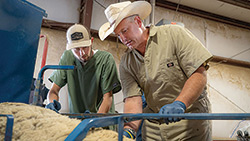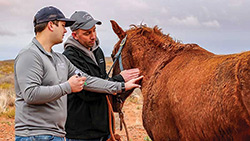 Utah State University will create a new College of Veterinary Medicine following a commitment by the Utah Legislature to provide significant ongoing state funding for what will be the first school of its kind in the state. The new college will help ease the shortage of veterinarians in the state and region, bolster the state’s growing life sciences technology sector, and partner with veterinarians in communities throughout the state. Utah State University will create a new College of Veterinary Medicine following a commitment by the Utah Legislature to provide significant ongoing state funding for what will be the first school of its kind in the state. The new college will help ease the shortage of veterinarians in the state and region, bolster the state’s growing life sciences technology sector, and partner with veterinarians in communities throughout the state.
“We are grateful to Gov. Spencer Cox and the state Legislature for supporting the new USU College of Veterinary Medicine,” said USU President Noelle E. Cockett. “We also appreciate Washington State University’s partnership over the last 10 years with the joint Doctor of Veterinary Medicine degree. It is now time for USU to address the growing shortage of veterinarians in our state, particularly in rural areas.”
 USU is currently part of the Washington-Idaho-Montana-Utah (WIMU) Regional Program in Veterinary Medicine and welcomed its 10th class of veterinary medicine students fall semester of 2021. In this program, USU admits up to 30 students each year, 20 of whom must be Utah residents. Students complete two years of foundational study at the Logan campus, and then move to Pullman, Washington, to complete their final two years of training at Washington State USU is currently part of the Washington-Idaho-Montana-Utah (WIMU) Regional Program in Veterinary Medicine and welcomed its 10th class of veterinary medicine students fall semester of 2021. In this program, USU admits up to 30 students each year, 20 of whom must be Utah residents. Students complete two years of foundational study at the Logan campus, and then move to Pullman, Washington, to complete their final two years of training at Washington State
University’s College of Veterinary Medicine, which includes clinical work with patients at the school’s veterinary hospital.
The state’s new appropriation of $18 million in annual funding, in addition to other funding streams, will allow USU to offer the state’s first four-year veterinary school.
“For years, Utahns interested in veterinary medicine were forced to go out of state for training,” Gov. Cox said. “That’s why we’re so excited and grateful that the Legislature funded the College of Veterinary Medicine at Utah State University. This investment is a long time coming and the new program will serve would-be veterinarians and the public for generations to come.”
 There are currently 33 accredited schools of veterinary medicine in the country. State Sen. Scott Sandall sees the new school as an important asset for Utah, which ranks 42nd in the nation for the number of veterinarians per capita, according to the U.S. Department of Labor. Utah is also among the states with the fastest-growing populations. There are currently 33 accredited schools of veterinary medicine in the country. State Sen. Scott Sandall sees the new school as an important asset for Utah, which ranks 42nd in the nation for the number of veterinarians per capita, according to the U.S. Department of Labor. Utah is also among the states with the fastest-growing populations.
“I am very pleased to have sponsored the appropriations request for the Utah State University College of Veterinary Medicine,” Sandall said. “It will be a jewel in the crown of our higher education system. Utah State University and our partnering veterinary practices will work together to help create opportunities for many students across the state of Utah and beyond.”
President Cockett noted the new college will provide educational opportunities for Utah students who otherwise would not be able to pursue a doctorate in veterinary medicine due to limited seats in veterinary medical schools and the requirement in USU’s current program to leave the state for two years.
“We also anticipate significant growth in research and technology development in the areas of veterinary and biological sciences, thereby providing another economic boost for the state,” said President Cockett.
Connections with animal science researchers at USU have helped fuel development and growth of biomedical technology companies that are important economic drivers and create jobs in northern Utah. Data from other schools indicate that every $1 the state invests in a school of veterinary medicine attracts an average of $2.50 of research funding.
USU’s Dean and Vice President for Agriculture and Extension Ken White notes that while care for companion animals is the limit of many peoples’ experiences with veterinarians, expert care for large animals and wildlife is a crucial part of public health and food safety. Animal agriculture in Utah is valued at more than $1 billion a year, with 25 of the state’s 29 counties reporting livestock operations as the dominant facet of their agricultural economy.
“Utah Veterinary Medical Association (UVMA) members are excited about legislators having funded the new school and look forward to seeing how it develops because it will have an important impact on veterinary medicine in the state,” said UVMA President, Dr. Jane Kelly. “Our members will be integral to the program as they host fourth-year students and faculty members in their clinics and hospitals. The new school will be an important asset for veterinarians throughout the state, many of whom are overwhelmed by the numbers of patients and clients they work so hard to serve.”
Rather than build and continue to staff, operate and update a large veterinary hospital, USU will use a model pioneered by other schools in the country. Fourth-year students, supervised by qualified faculty veterinarians and working with specialists who are board-certified, will receive clinical training at veterinary practices throughout the state. Participating veterinarians will be compensated for hosting and mentoring students, and their patients will have access to visiting specialists’ expertise.
The Projected Timeline
Students admitted for fall semester 2024 will complete all four years of the DVM program in Utah. Those 40 students — 30 of whom will be Utah residents — will have applied in 2023.
The following year, plans call for a new teaching and research facility dedicated to veterinary medicine to be completed. At that point, USU’s College of Veterinary Medicine will admit 80 students per year.
|